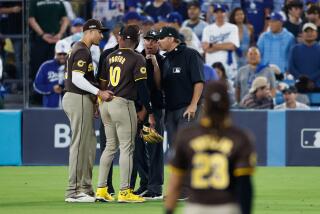Stadium Gets Best, Worst of GameŌĆÖs Best
SAN DIEGO ŌĆö You get a full house at San Diego Jack Murphy Stadium, and the place historically turns into a lunatic. ItŌĆÖs much more inmate than asylum. It takes on a vitality of its own and crazy things happen.
Toss in a full moon to go with that full house, and it should almost be enough to scare the skunks out from behind the Padre bullpen.
ItŌĆÖs like the stadium sees all those strange and unfamiliar faces and decides to show off. It loves offense, probably catching that from its long association with Don Coryell. Give it a full house and watch players perform to its every whim.
You want evidence?
Darned near any Holiday Bowl.
That was where San Diego Jack Murphy Stadium earned its reputation, with BYU and any given yearŌĆÖs designated opponent running points onto the scoreboard as fast as a checker totals groceries. BYU came from 21 back to win one of those games, 46-45, in the last four minutes. It got into a 50-35 shootout with conservative black shoes-white helmet Penn State, of all people.
You think it was just BYU? No way. San Diego State fell under the stadiumŌĆÖs spell when it made its only Holiday Bowl appearance, a frenzied 39-38 loss to Iowa in the final seconds.
And it doesnŌĆÖt even have to be a Holiday Bowl. All it takes is a packed house for this park to work its maniacal magic. The wildest of the wild was that 52-52 tie between SDSU and BYU for the 1991 Western Athletic Conference championship.
OK, so those are all college kids. Maybe theyŌĆÖre more vulnerable to voodoo, right?
How about the only Super Bowl played here?
Never before or since in the history of Super Bowls has there been a quarter like the one produced by San Diego Jack Murphy Stadium. Notice I said by rather than in San Diego Jack Murphy Stadium. The Washington Redskins were credited with 35 points against the Denver Broncos in that second quarter, but we realize the stadium itself controls the destiny of its occupants at times like that.
For all this time, though, baseball had managed to escape this insanity. The peaceful, pastoral national pastime has maintained its dignity. This place could turn carny fun house for football, but baseball insisted on an almost monastic order.
They actually played an All-Star game here in 1978 and no one even hit a home run. The National League won, 7-3, and it was so orderly that Steve Garvey was the MVP.
I suspected it would be different this time around. Baseball had had its way with this stadium for too long. You can only thumb your nose at a monster for so long.
If there was a clue, it came Monday. I watched Mark McGwire pound pitch after pitch into the seats during the home run derby at the All-Star workout.
I knew it then.
This was the time the stadium would take baseball and say, ŌĆ£Excuse me, but itŌĆÖs my turn. WeŌĆÖll do this one my way. So what if itŌĆÖs your so-called Midsummer Classic.ŌĆØ
It did it its way . . . as in 13-6, American League. YouŌĆÖd wondered if maybe it was low-scoring football, if you didnŌĆÖt know the stadium.
And boy was it cruel. You can have all the offense in football and the fans grumble about the collective defense. What happened Tuesday night was that the American League tomahawked AtlantaŌĆÖs Tom Glavine into embarrassment. The mound is a lonely place in moments such as that, and Glavine was the one standing on it.
You know how this stadium craves offensive records. It didnŌĆÖt mess around at all. The American League got seven consecutive hits in the first inning, an all-time record for a game dating back to 1933. It scored four runs, the most in the first inning of an All-Star game since 1977.
Unfortunately, baseball has victims of such treachery and the stadium wasnŌĆÖt too fussy. It chose Glavine, the 1991 Cy Young Award winner and a 13-3 pitcher thus far in 1992. He now holds ignominious records for most hits allowed in an inning and a game. Poor Tommy knows a little bit what itŌĆÖs like to be a DB in a Holiday Bowl, only worse.
WhatŌĆÖs more, Glavine happened to have the bad luck of being the first guy out there, when the crowd was still edgy with anticipation and the President was still around. All nine hits he gave up were singles. Bob Tewksbury gave up three doubles and a home run in the sixth inning .
And then along came Jones. Doug, that is. He gave up three runs on four hits in the eighth inning, including a single by Chuck Nagy, an AL pitcher who had never been to the plate. That may be the ultimate humiliation this park inflicted on anyone in its night of gory glory.
This stadium lusts for records and it got one for most hits in a game, 19 by the American League, tied another for most runs, 13, by the AL, tied another for most hits by both teams, 31, and threatened one it really would have liked, most runs both teams, 20.
IŌĆÖll tell you what. This stadium, having its own way, would have owned all those records. It just didnŌĆÖt count on one of its own, Tony Gwynn, throwing two runners out from right field. It will forgive him, to be sure. A park so in love with offense cannot stay mad long at a four-time batting champion.
More to Read
Go beyond the scoreboard
Get the latest on L.A.'s teams in the daily Sports Report newsletter.
You may occasionally receive promotional content from the Los Angeles Times.










